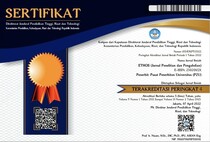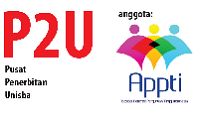Increasing Production, Marketing, and Diversification of Mocaf-Based Product
Abstract
Abstract. The problem for small businesses of mocaf-based products is drying. Thus, a dryer is needed which will be attempted through an apprenticeship program. Another problem is the need to expand the type of business. Through the diversification of cassava products, it produces mocaf noodles which can be sold at higher prices, thereby increasing income and improving people's welfare. The aim of PkM is to increase and maintain production continuity, as well as increase profits through the creation of derivative products. The target audience is people who are already engaged in the mocaf flour business and small culinary entrepreneurs. The training method is in the form of tutorials and technical training by integrating Islamic values into it. Based on the results of the apprenticeship, small ovens can be made by themselves. However, the production of large ovens cannot be completed considering there is still a shortage of funds. The manufacture and marketing of noodles have been occupied by several small culinary entrepreneurs and sold to meatball traders, as well as sold to consumers who have been customers before. The conclusion is that in order to increase mocaf flour production, it is necessary to make a good drying oven. The PkM team was able to build only 75% of the drying ovens, so more assistance and funding was needed. From the perspective of increasing mocaf-derived products, mocaf noodles are a profitable option, and giving rise to many new entrepreneurs.
Full Text:
PDFReferences
Adepoju, A. O., & Oyewole, O. O. (2013). Households’perception And Willingness To Pay For Bread With Cassava Flour Inclusion In Osogbo Metropolis, Osun State, Nigeria.
Amanu, F. N., & Susanto, W. H. (2014). Pembuatan tepung mocaf di madura (kajian varietas dan lokasi penanaman) terhadap mutu dan rendemen [IN PRESS JULI 2014]. Jurnal Pangan Dan Agroindustri, 2(3), 161–169.
CNBCIndonesia. (2021). Via Shopee, 1,5 Juta Produk RI Sudah Diekspor ke 6 Negara.
FAO. (2014). The state of food and agriculture (online).
Hamali, A. Y. (2016). Pemahaman Strategi Bisnis dan Kewirausahaan. 2016. Cetakan Ke-1. Prenadamedia Group. Jakarta.
Handayani, T., & Fathoni, M. A. (2019). Buku Ajar Manajemen Pemasaran Islam. deepublish.
Hardono, G. S. (2014). Strategi pengembangan diversifikasi pangan lokal.
Jony, J., Sitorus, S. A., Hana, K. F., Purba, B., Basmar, E., Hasyim, H., Sugiarto, M., Simanjuntak, M., & Sariyanto, S. (2021). Pemasaran Usaha Kecil Menengah. Yayasan Kita Menulis.
Kemi, A. O. (2016). Diversification of Nigeria economy through agricultural production. Journal of Economics and Finance, 7(6), 104–107.
Mukti, T., & Elida, S. (2017). Analisis Kelayakan Usaha Agroindustri Mie Sagu di Kecamatan Tebing Tinggi Kabupaten Kepulauan Meranti. Dinamika Pertanian, 33(2), 145–154.
Oktini, D. R., Effendi, R., Nugraha, Y. D., & Permana, R. M. T. (2022). Peningkatan Ekonomi Melalui Pengolahan Tepung Mocaf Pada Masa Pandemi Covid-19. ETHOS: Jurnal Penelitian Dan Pengabdian Kepada Masyarakat, 10(1), 101–113.
Orji, M. C. (2018). Diversification of Nigeria’s economy through agriculture and solid minerals in the face of dwindling economy. International Journal of Advance Research and Innovation, 6(3), 147–151.
Rivai, V., Nuruddin, A., & Arfa, F. A. (2012). Islamic business and economic ethics: mengacu pada AlQur’an dan mengikuti jejak Rasulullah SAW dalam bisnis, keuangan, dan ekonomi. Bumi Aksara.
Ruriani, E., Nafi, A., Yulianti, L. D., & Subagio, A. (2013). Identifikasi potensi MOCAF (Modified Cassava Flour) sebagai bahan pensubstitusi teknis terigu pada industri kecil dan menengah di Jawa Timur (Potency Identification of MOCAF (Modified Cassava Flour) as technical substitution of wheat flour in small and me. Jurnal Pangan, 22(3), 229–240.
Sari, I. K. (2021). Teknik Pembuatan Tepung & Mie Mocaf. CV Media Sains Indonesia.
Shitu, A. M. (2017). Economic diversification in recession: A case of Nigerian agriculture as a sign post for national development and sustainable growth. International Journal, 5(1).
Suberu, O. J., Ajala, O. A., Akande, M. O., & Olure-Bank, A. (2015). Diversification of the Nigerian economy towards a sustainable growth and economic development. International Journal of Economics, Finance and Management Sciences, 3(2), 107–114.
UNCTAD. (2015). Economic diversification, non-farm activities and rural transformation”, The Least Developed Countries Report.
Uzonwanne, M. C. (2015). Economic diversification in Nigeria in the face of dwindling oil revenue. Journal of Economics and Sustainable Development, 6(4), 61–67.
DOI: https://doi.org/10.29313/ethos.v11i2.10118
Refbacks
- There are currently no refbacks.
Alamat Redaksi:
LPPM Unisba, Lantai 2, Jl. Purnawarman 63, Bandung 40116, Jawa Barat, (022) 4203368 , (022) 4264064. ethos.unisba@gmail.com / ethos@unisba.ac.id

This work is licensed under a Creative Commons Attribution-NonCommercial-ShareAlike 4.0 International License.














